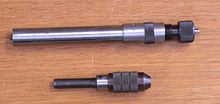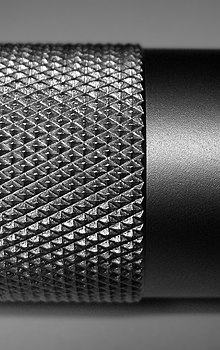Knurling

Knurling and cord are two related manufacturing processes from the group of embossing, which is part of pressure forming . In both processes, a round workpiece is pressed against another round tool and rolled so that both rotate. The profile of the tool is transferred to the workpiece. The elevations of the tool are pressed into the surface of the workpiece. Depending on whether knurls or cords (left-right knurls, cross knurls) are produced, one speaks of "knurling" or "cord".
For example, the handles or gripping surfaces of micrometers are often knurled to make them easier to grip than smooth surfaces.
Applications
Knurling for embossing ornamental elements or writing on the edge of a coin or medal used to make "filing" or "trimming" (measures to achieve a profit by reducing the size of precious metal coins) of the coins more difficult because a filing point is immediately visible .
Another application is the creation of a serrated profile for a shaft-hub connection , e.g. B. for fastening a rotor assembly on a shaft in order to transmit higher torques than with a shrink connection or knurled screw .
With knurling, a distinction is made between non-cutting "knurl pressing" and cutting "knurling milling". Depending on the process, the profile is pressed in with knurling wheels or milled on a knurl milling machine. Special knurling tools can also be used on CNC lathes with driven tools in order to avoid reclamping on other machines. Since the machining forces are lower during milling , it is mainly used for thin workpieces or on machining centers .
There are knurls in the following designs:
- RAA: knurl with axially parallel grooves
- RBL: left knurl
- RBR: knurled right
- RGE: left-right knurl, points raised (checkering)
- RGV: left-right knurl, points deepened
- RKE: cross knurl, points raised
- RKV: cross knurl, deepened points
- RTR: Circular knurling (continuous)
The profile angle is 90 °, in special cases also 105 °.
Designation: z. E.g. "Knurl RAA 08-105" = knurl with axially parallel grooves, pitch 0.8 mm and profile angle 105 °
Norms
- Currently: DIN 8583-5, DIN 82 , DIN 403
- Switzerland: VSM 34060. Conversion to DIN 82: "Kordel VSM 34060 - x, y" corresponds to "RGE - x, y DIN 82" and "Knurled VSM 34060 - x, y" corresponds to "RAA - x, y DIN 82"
See also
literature
- Raphael Petry: Impressions in: Hartmut Hoffmann , Reimund Neugebauer , Günter Spur : Handbuch Umformen , Hanser, 2012, p. 312 f.
Web links
Individual evidence
- ↑ Helmut Kahnt, Bernd Knorr: Old dimensions, coins and weights. A lexicon. Bibliographisches Institut, Leipzig 1986, licensed edition Mannheim / Vienna / Zurich 1987, ISBN 3-411-02148-9 , p. 382.
- ↑ Helmut Kahnt, Bernd Knorr: Old dimensions, coins and weights. A lexicon. 1987, p. 395.
- ↑ Query on January 6, 2008
- ↑ Knurling tool manufacturer Ifanger ( Memento of the original from December 7, 2013 in the Internet Archive ) Info: The archive link was automatically inserted and not yet checked. Please check the original and archive link according to the instructions and then remove this notice.

